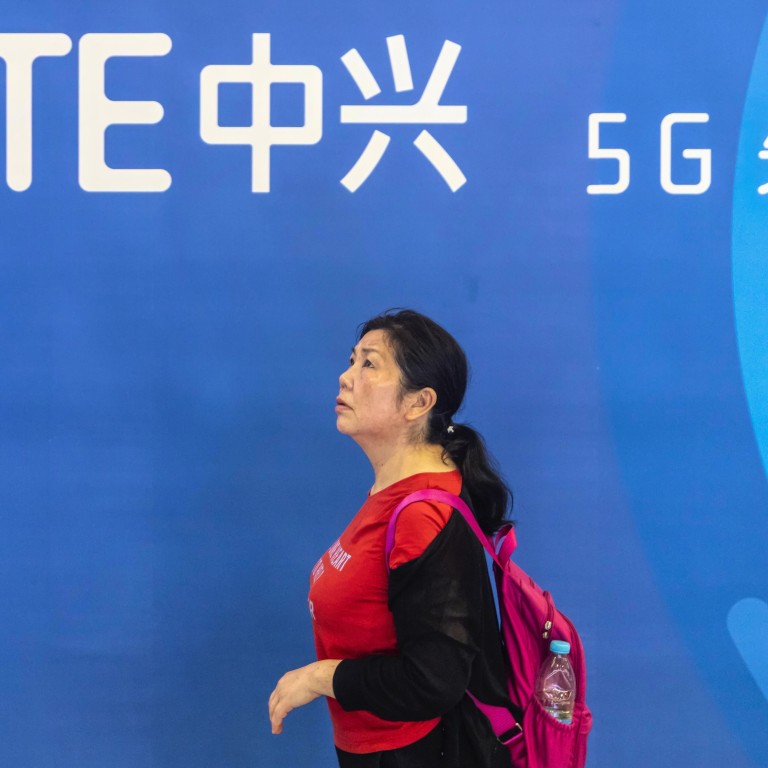
ZTE secures more than 25 commercial 5G network contracts as it steps up turnaround efforts
- Chinese telecoms gear maker also has 5G partnership commitments with more than 60 carriers worldwide
ZTE Corp, the world’s fourth largest telecommunications equipment supplier, said it has secured more than 25 commercial 5G network contracts to date, as the company moves to turn around its business this year after being on the brink of collapse because of US-imposed sanctions last year.
Shenzhen-based ZTE also indicated that more deals are in the works, based on its 5G partnership commitments with more than 60 telecoms network operators around the world, according to a press release from the company on Tuesday.
That news, however, failed to boost the company’s share price, which was down 2.49 per cent to HK$21.50 at the close of trading on Tuesday in Hong Kong.
ZTE’s latest tally of 5G network equipment supply contracts puts it ahead of Sweden’s Ericsson, which has reported 22 5G contracts. Huawei Technologies, the world’s largest telecoms gear supplier, remains ahead in the market with 50 announced 5G network deals, while Finland’s Nokia had 43 contracts.

The four companies are competing worldwide to supply ultra-fast 5G mobile networks – estimated to provide peak data rates up to 100 times faster than 4G – that will help power the industrial internet, autonomous driving and smart cities.
5G-related capital expenditure is forecast to reach US$123 billion in 52 markets by 2020, according to data from research firm Dell’Oro Group.
While South Korea, the US, Australia and the UK have launched initial commercial 5G mobile services in the second quarter, the scale of China’s market – where crosstown rivals Huawei and ZTE are the main suppliers – is likely to dwarf the combined size of those economies, negating any first-mover advantage.
Huawei wins half of China Mobile’s 5G network contracts while Ericsson picks up a third
China Mobile, the world’s largest wireless network operator, announced last week a part of the results of its initial 5G equipment tender covering 40 cities, in which ZTE was awarded 5 per cent of the MME/SGSN equipment contracts and 3 per cent of the SAE-GW/GGSN system. MME/SGSN provides optimisation and control of device signalling in a 5G network, while SAE-GW/GGSN is responsible for management and delivery of data traffic.
By comparison, Huawei won 49 per cent of the MME/SGSN contracts and 54 per cent of the SAE-GW/GGSN orders.
Those results, however, are “not indicative of ZTE’s real 5G share”, said Jefferies equity analyst Edison Lee in a report last week.
Lee said the announced results covered “the original vendor for the 2G core networks in those selected 40 cities”. “ZTE’s share in China Mobile’s 2G network, which was built in the late 90s and early 2000s, is only single-digit percentage,” he said.
What will 5G in China mean for you?
In April, ZTE predicted a turnaround in its business this year, with a projected net profit of between 1.2 billion yuan and 1.8 billion yuan (US$174 million and US$262 million) in the first half, compared to its 7.8 billion yuan loss during the same six-month period in 2018, as business continues to improve after a near-death experience last year.
In June last year, ZTE agreed to pay an additional US$1 billion in fines to the US Department of Commerce and put up US$400 million as surety to settle its violation of US prohibitions against selling American technology to Iran. This deal also required the company to replace its board and terminate all executives ranked above senior vice-president, as well as anyone involved in the Iran violations.
Huawei rivals Nokia, Ericsson no shoo-in for 5G contracts as China seen favouring local champions
“With innovation as the driving force, ZTE has made 5G its core development strategy,” the company said on Tuesday, echoing its statement in March that it will ratchet up 5G research and development.
The company said it has filed more than 3,500 5G patent applications and collaborated with more than 20 operators around the world in the development of 5G terminals, including smartphones, routers and mobile hotspots.
ZTE also unveiled its first flagship 5G smartphone, the Axon 10 Pro, at the MWC Barcelona 2019 trade show held in Spain in February. That handset is expected to be released in China, Germany, the United Arab Emirates, Finland and Austria later this year.

